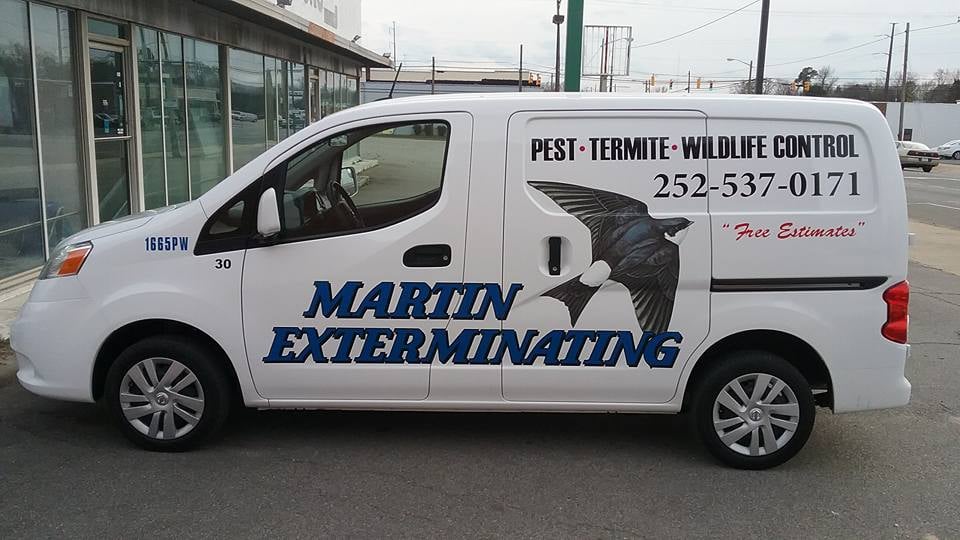The Most Effective Way
To Get Rid of Pests
We work hard to help keep you in a safe, pest free environment for one less thing to worry about.
The Experts You Can Trust
Martin Exterminating
Martin Exterminating Company is a locally owned and operated family business for over 50 years! We provide pest control, termite control, mosquito control, moisture control, wildlife control, crawl space encapsulation, and even insulation removal and installation!
N.C. Pest Control License 1665PW.
Licensed in North Carolina and Virginia.


All-In-One Solution For
Pest Control Services
At Martin Exterminating, we stand behind every inspection and service our expert pest control technicians perform. Whether it’s for your home or business, we’re fully ready and equipped to tackle even the most extensive pest problems. Contact our experts today to schedule an inspection, your satisfaction is guaranteed!
We Specialize In Creating
Happy Clients
FAQ's
Frequently Asked Questions
How does pest control insulation work?
Pest control insulation works by combining traditional insulation properties with pest-repellent capabilities. This type of insulation is treated with materials that deter common pests such as insects and rodents, creating an added layer of protection for your home. The treated fibers disrupt the insects’ natural systems, making your home a less inviting environment for them. At the same time, it functions as an effective insulator, maintaining energy efficiency and regulating indoor temperatures.
One significant benefit of pest control insulation is that it provides long-term protection without the need for constant reapplications or harsh chemicals. It can be installed in spaces like attics and walls, where pests often enter and nest, reducing the chances of infestations. Additionally, this insulation not only deters pests but also contributes to better air quality and a more comfortable living environment, making it an all-round solution for home protection and insulation needs.
Is it safe to use pesticides for mosquito control?
When used correctly and according to the manufacturer’s instructions, pesticides for mosquito control can be safe and effective. Many mosquito control products are designed to target the pests specifically while minimizing risks to humans and pets. To ensure safety, these products should only be applied in designated areas, kept away from food and water sources, and used in the recommended quantities. Reading the label carefully and adhering to safety guidelines is crucial for reducing potential hazards.
However, it’s important to consider proper handling and storage of pesticides to avoid unintended exposure or misuse. For example, wearing protective gear during application and keeping children and pets away from treated areas until the product has dried can significantly improve safety. Additionally, some alternatives, like natural repellents or physical barriers, may be suitable for those looking to reduce chemical exposure. Proper use and understanding of pesticides can help you effectively manage mosquitoes while safeguarding your health and the environment.
What is backyard mosquito control?
Backyard mosquito control refers to the methods used to reduce or eliminate mosquito populations in residential outdoor spaces. These measures are designed to make your yard more enjoyable and less of a breeding ground for mosquitoes. Common strategies include removing standing water, where mosquitoes lay their eggs, and maintaining your yard by trimming overgrown vegetation, which can serve as shelter for adult mosquitoes.
Other effective methods of backyard mosquito control often involve natural or chemical treatments. Natural options include using citronella candles, planting mosquito-repellent plants, or introducing beneficial insects like dragonflies that feed on mosquitoes. For chemical approaches, products like outdoor sprays or larvicides can target mosquito larvae or adults. Combining multiple control methods typically yields the best results, helping to create a mosquito-free environment for you and your family to enjoy outdoor activities.
What is attic moisture control and why is it important?
Attic moisture control refers to the processes and measures used to manage humidity levels and prevent excess moisture buildup in an attic space. This can involve proper ventilation, insulation, and steps to address sources of moisture, such as roof leaks or inadequate ventilation systems. Maintaining a balanced level of moisture in the attic helps to protect the integrity of the structure and minimize the risk of issues like mold growth, wood rot, or insulation damage.
The importance of attic moisture control cannot be overstated, as unmanaged moisture can lead to costly damage over time. Excessive moisture not only compromises the structural components of the attic and the roof but can also have health implications by encouraging mold and mildew growth. Controlling moisture helps extend the lifespan of the roof and surrounding materials while also improving indoor air quality. By addressing attic moisture effectively, you contribute to the overall health and safety of your home.
How can I find the best pest and wildlife control services in my area?
Finding the best pest and wildlife control services in your area starts with research and gathering recommendations. Begin by asking friends, family, or neighbors for referrals based on their personal experiences. Online reviews and ratings can also provide insight into the quality and reliability of local services. Look for companies with consistently positive feedback and a history of satisfied customers.
Additionally, it’s important to verify credentials to ensure the service provider is reputable and qualified. Check for proper licensing, certifications, and insurance, as these indicate professionalism and compliance with safety standards. Comparing several providers, asking detailed questions about their methods, and understanding how they handle specific pest or wildlife issues will help you make an informed decision. Taking the time to evaluate your options ensures you choose a service that meets your needs and provides effective, responsible solutions.
How does outdoor mosquito control work?
Outdoor mosquito control works by targeting both the mosquitoes and their breeding environments to reduce their population and prevent bites. One common method is applying targeted treatments to areas where mosquitoes rest or breed, such as tall grass, shaded areas, and standing water. These treatments often involve environmentally safe products designed to kill adult mosquitoes or larvae before they can develop into biting insects.
Another crucial aspect of mosquito control is habitat reduction. By eliminating standing water around your property—like removing debris, cleaning gutters, or filling in low-lying areas—you can prevent mosquitoes from laying eggs. Preventive measures, such as installing screens on outdoor spaces and using plants that naturally repel mosquitoes, also help create a less inviting environment for them. Together, these strategies form a comprehensive approach to keeping outdoor spaces more comfortable and mosquito-free.
What is the best mosquito control method?
The best mosquito control method often depends on the specific environment and level of infestation. One highly effective approach is eliminating mosquito breeding grounds by removing standing water where they lay eggs. This includes tasks like emptying unused containers, cleaning gutters, and covering water storage areas. Reducing these habitats can significantly lower mosquito populations over time.
Additional measures such as using mosquito repellents, installing screens, and wearing protective clothing can help prevent bites. For more targeted control, treatments like sprays or larvicides can be applied to areas where mosquitoes are most active or breeding. Combining these methods provides a comprehensive strategy to manage mosquitoes effectively, ensuring both immediate relief and long-term prevention.
What are the best products for mosquito control?
A variety of products can effectively manage mosquito populations, and the best choice often depends on your specific situation. For personal protection, insect repellents applied to the skin or clothing are highly effective at preventing bites when you’re outdoors. For larger areas like a yard, mosquito traps can significantly reduce the number of biting insects by attracting and capturing them. Another powerful tool is larvicides, which are products designed to be placed in standing water sources that cannot be eliminated. These larvicides kill mosquito larvae before they can mature into flying adults, targeting the problem at its source.
When selecting mosquito control products, it is important to consider both effectiveness and safety. Always read and follow the product labels carefully, especially if you have children or pets. For treating standing water in birdbaths or fish ponds, look for larvicides specifically formulated to be safe for wildlife. Combining different types of products, such as using larvicides to prevent breeding and traps to capture existing adults, often yields the most comprehensive and lasting results for controlling mosquitoes around your home.
Is wildlife pest control safe for the animals?
Yes, reputable wildlife pest control focuses on humane and safe methods for managing animal intrusions. The primary goal is not to harm the animals but to safely and effectively remove them from your property and prevent their return. Professionals use techniques that are specifically designed to minimize stress and risk to the wildlife. This often involves using live traps and exclusion methods that are tailored to the specific species, ensuring the animal can be captured without injury and handled in a way that prioritizes its well-being.
The process extends beyond simple removal to ensure long-term safety for both the animals and the property owner. After an animal is safely captured, it is often relocated to a more suitable natural habitat, following local regulations. The focus then shifts to prevention. This includes identifying and sealing entry points, modifying the habitat to make it less attractive to wildlife, and providing homeowners with education on how to avoid future conflicts. This comprehensive approach ensures the problem is resolved humanely and effectively, respecting the animal while securing your home.
What is rodent pest control?
Rodent pest control is a comprehensive process designed to manage and eliminate infestations of rodents like mice and rats from a property. The process typically begins with a thorough inspection to identify the type of rodent, the extent of the infestation, and the entry points they are using to access the building. This initial assessment is crucial for developing an effective strategy that not only removes the current pests but also prevents them from returning. It involves looking for signs of activity such as droppings, gnaw marks, nests, and tracks.
Based on the inspection, a combination of methods is used to address the problem. These can include setting traps, using baits in secure stations, and implementing exclusion techniques to seal off access points like cracks in the foundation, gaps around pipes, and vents. The goal is to create a rodent-proof environment. Proper sanitation and habitat modification, such as removing food sources and clutter, are also essential components of a long-term solution. By taking these steps, rodent pest control helps protect a property from damage and safeguards the health and safety of its occupants.
How do I prevent moisture in my attic?
Preventing moisture in your attic is essential for maintaining a healthy home and avoiding issues like mold, mildew, and wood rot. The most important factor in managing attic moisture is ensuring proper ventilation. A well-designed ventilation system creates continuous airflow that pushes warm, moist air out while pulling in cooler, drier air. This is usually achieved with a balanced combination of intake vents located at the lower part of the roof (like soffit vents) and exhaust vents at the highest point (like ridge vents). This airflow prevents condensation from forming when warm, humid air from your living space meets the cold surfaces of the attic.
Another critical step in learning how to control moisture in attic spaces is to stop it from getting there in the first place. You can do this by air sealing any gaps or cracks between your main living area and the attic floor. Common culprits for air leaks include openings around light fixtures, plumbing pipes, attic hatches, and electrical wiring. Using caulk or spray foam to seal these points is an effective solution. Additionally, you should verify that all exhaust fans from bathrooms, kitchens, and laundry rooms are ducted to vent directly outside and not into the attic, as this is a common source of concentrated moisture.




